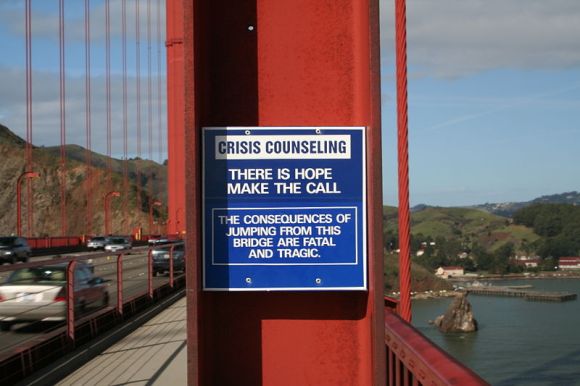
Japan often gets a reputation as a suicide-heavy nation but the social problem of self-destruction is something all parts of the world have to tackle.
The following is a list of five places in the world where suicides have most often occurred. It’s a bittersweet honor in that they are all either places of extreme natural beauty of impressive feats of engineering.
On the other hand, they are also places and countries that clearly do too little to prevent either the mental illness that leads to suicide of the act itself.
5 – Niagara Falls (Canada/USA)
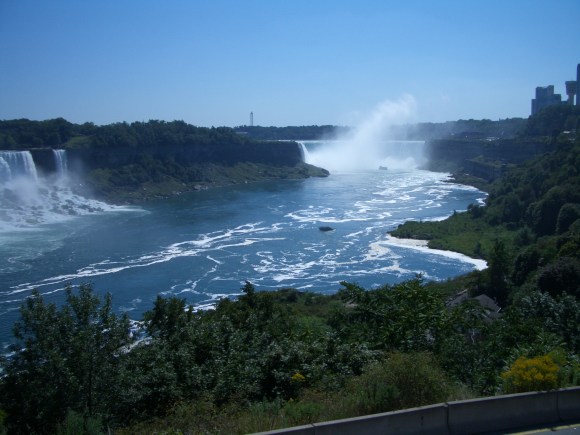
The gorgeous Niagara Falls which straddles the Canadian-US border is often informally referred to as the “honeymoon capital of the world” with its picturesque scenery of lush blue and green. Apparently it’s that same romanticism that drives people to jump over the rocky edges into the fiercely powerful water.
A local historian claimed that 2,780 known suicides occurred around the falls from 1856 to 1995. Of Niagara Falls jumpers there has been a disproportionately large number of female victims (41%) compared to the rest of America.
4 – The Gap (Australia)
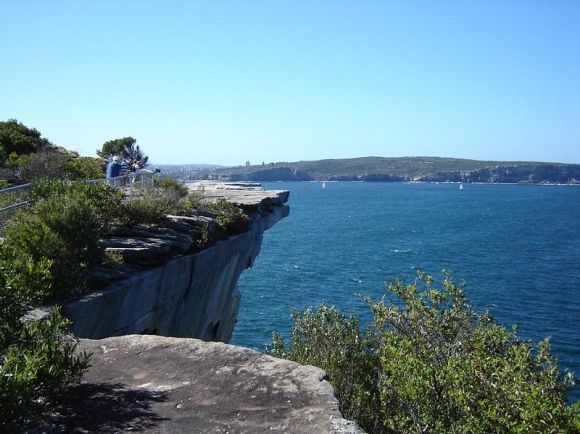
On the other side of the world it’s the same story. The beautiful cliffs of The Gap on South Head peninsula are part of a pleasant sightseeing spot that draws scores of people. However, an estimated 50 of the visitors per year go there with another agenda.
One bright spot in this is a man named Don Ritchie. Don was a WWII veteran, full-time insurance salesman, and part-time greatest guy who ever lived. Over a span of 45 years he rescued at least 160 people from themselves just by lending them an ear and an occasional beer. Sadly, Mr. Ritchie is no longer with us but he lives on as an inspiration of how easy it can be to change people’s lives for the better.
3 – Golden Gate Bridge (USA)
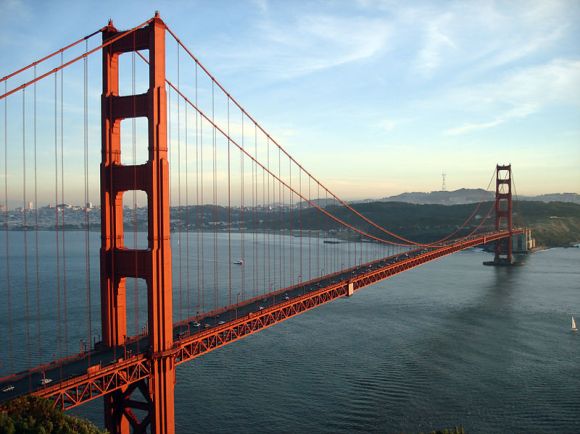
What really needs to be said about the Golden Gate Bridge? It’s viewed by tourists from around the world daily and is considered to be one of (if not the) most beautiful bridges in the world. I can’t help thinking about the beginning of Full House when I see it, but that’s my own issue.
Its other reputation was the subject of a 2006 documentary The Bridge. The movie references two jumping survivors, Ken Baldwin and Kevin Hines who both admitted to changing their minds only after making their potentially fatal jump.
As of 2005, the official suicide count was over 1,200. Very few efforts have been made to erect a fence reportedly due to budget and aesthetic concerns.
2 – Nanjing Yangtze River Bridge (China)
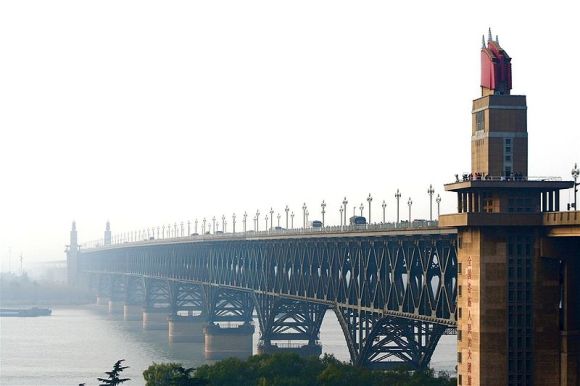
The Nanjing Yangtze River Bridge was a major achievement for the then recently in-power People’s Republic of China. Built entirely by the might of the nation it was the first industrial strength bridge of its kind there. When completed in 1968, it provided a much needed transportation link between Beijing and Shanghai.
Since then it has also attracted over 2,000 jumpers. This is considered to be a gross underestimate though and little effort from the government has been made to deter suicides.
And yet another heroic local named Chen Si has taken it upon himself to help out. If you’re ever around the bridge on a weekend you’ll probably see him with a baseball cap and pair of binoculars on patrol during his off time and saving over 100 lives (possibly 200 by now). However, if you’re planning to do something rash on the Nanjing Yangtze River Bridge, he’ll find you.
1 – Aokigahara Forest (Japan)
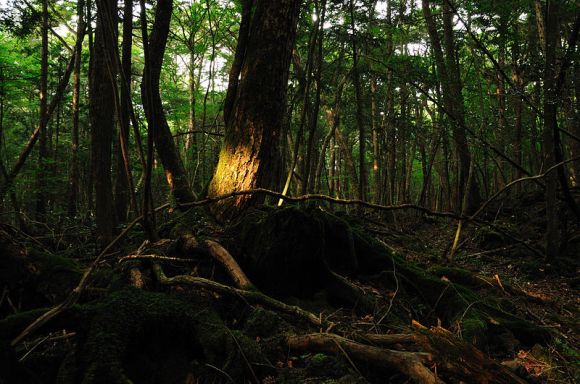
Also known as the “Sea of Trees” this sprawling forest rests at the foot of Mount Fuji.
Its reputations as a place of mystery and a location for suicide have fueled each other over the years snowballing into what is possibly the most active place for suicides in the world.
Much of the mystical reputation of Aokigahara may come from the old saying “once you set foot in Aokigahara you don’t come out.” However, this was probably referring to the very rough terrain of the deep forest carved out by volcanic activity.
Nevertheless, urban legends surrounding the area endure. Some believe that compasses or GPS can’t function which any soldier in training can tell you is false (aside from GPS being affected by the tree cover).
There is also a belief that digital clocks go haywire when passing through or near the forest – a claim that has about as much validity as saying Candyman in the mirror three times.
The number of suicides in Aokigahara tends to spike during times when film or television adaptations of a popular novel that deals with suicide and this forest Tower of Waves (Nami no To) are released. This is probably more due to heightened media attention than an actual rise in suicides though.
The real cause of Aokigahara and Japan’s large number of suicides is likely connected to the lingering stigma attached to mental illness which dissuades many from getting their needed treatment.
■
In the end, these rankings cannot be considered accurate because it’s impossible to accurately count the number of suicides that take place 24/7 and the top three especially could be completely reversed. It’s not the statistics that are important anyway.
We could point the finger at the places themselves for not setting-up the proper equipment or blame governments for not having adequate mental health programs for all.
Or, instead of waiting for someone else to do it, we could take the examples set by Chen Si and Don Ritchie and do something about it ourselves – starting with the people closest to you.
Source: Karapaia (Japanese)
Top Image: Wikipedia – David Corby
Aokigahara Video: YouTube – JGSD Fomega
Chen Si Video: YouTube: 冬烨 马
Don Ritchie Video: YouTube –CommBank
▼ Video showing some of a regular corpse patrol of Aokigahara. Images may be disturbing.
▼ Interview with Chen Si. Images may be inspiring.
▼ Short interview with Don Ritchie shortly before his passing.

 The top 10 haunted spots in Japan as chosen by a professional ghost chaser
The top 10 haunted spots in Japan as chosen by a professional ghost chaser Japan’s oldest largetooth sawfish in captivity back on display in Mie Prefecture
Japan’s oldest largetooth sawfish in captivity back on display in Mie Prefecture Cute Anime Girls Driving Sales of Windows 8 in Japan
Cute Anime Girls Driving Sales of Windows 8 in Japan We found possibly the quietest Japanese-style hotel in Tokyo’s bustling Shinjuku district
We found possibly the quietest Japanese-style hotel in Tokyo’s bustling Shinjuku district Starbucks Japan ready to get Year of the Horse started with adorable drinkware and plushies【Pics】
Starbucks Japan ready to get Year of the Horse started with adorable drinkware and plushies【Pics】 Convenience store fried chicken going into school lunches in Japan for Family Mart anniversary
Convenience store fried chicken going into school lunches in Japan for Family Mart anniversary Japanese thug wear from Birth Japan perfect for those breaking bad next year
Japanese thug wear from Birth Japan perfect for those breaking bad next year How should you respond when a Japanese person gives you a compliment?
How should you respond when a Japanese person gives you a compliment? Japanese group to hold fashion show of colostomy bags and other stoma equipment in Paris
Japanese group to hold fashion show of colostomy bags and other stoma equipment in Paris Foreign tourist in Japan arrested for having sex on shrine grounds in broad daylight
Foreign tourist in Japan arrested for having sex on shrine grounds in broad daylight Highly toxic plant found for first time in Japan on Hokkaido University campus
Highly toxic plant found for first time in Japan on Hokkaido University campus 7-Eleven Japan’s ramen-cooking robot whipped us up a bowl of noodles【Taste test】
7-Eleven Japan’s ramen-cooking robot whipped us up a bowl of noodles【Taste test】 Lacquerware supplier to emperor of Japan and Pokémon team up for new tableware
Lacquerware supplier to emperor of Japan and Pokémon team up for new tableware Cyberpunk anime meets traditional culture in Ghost in the Shell gold leaf Japanese changing screens
Cyberpunk anime meets traditional culture in Ghost in the Shell gold leaf Japanese changing screens 7 great places to see Mt. Fuji from without having to climb it
7 great places to see Mt. Fuji from without having to climb it Japan may add Japanese language proficiency, lifestyle classes to permanent foreign resident requirements
Japan may add Japanese language proficiency, lifestyle classes to permanent foreign resident requirements Hello Kitty Choco Egg figures are an adorable trip through three periods of Japanese pop culture【Pics】
Hello Kitty Choco Egg figures are an adorable trip through three periods of Japanese pop culture【Pics】 Japan’s otoshidama tradition of giving kids money at New Year’s gets a social welfare upgrade
Japan’s otoshidama tradition of giving kids money at New Year’s gets a social welfare upgrade Starbucks Japan releases new zodiac chilled cup drink for 2026
Starbucks Japan releases new zodiac chilled cup drink for 2026 Can a dirty butthole make you filthy rich in Japan? We’re starting a New Year’s lottery experiment
Can a dirty butthole make you filthy rich in Japan? We’re starting a New Year’s lottery experiment 7-Eleven Japan starts new temporary luggage storage service in over 300 branches
7-Eleven Japan starts new temporary luggage storage service in over 300 branches Disillusionment at Tsukiji’s tourist-target prices led us to a great ramen restaurant in Tokyo
Disillusionment at Tsukiji’s tourist-target prices led us to a great ramen restaurant in Tokyo Starbucks teams up with 166-year-old Kyoto doll maker for Year of the Horse decorations【Photos】
Starbucks teams up with 166-year-old Kyoto doll maker for Year of the Horse decorations【Photos】 Tokyo considering law requiring more trash cans following litter increase in heavily touristed area
Tokyo considering law requiring more trash cans following litter increase in heavily touristed area Tokyo’s Tsukiji sushi neighborhood asks tour groups to stay away for the rest of the month
Tokyo’s Tsukiji sushi neighborhood asks tour groups to stay away for the rest of the month Nintendo’s Kirby now delivering orders at Kura Sushi restaurants, but not in Japan
Nintendo’s Kirby now delivering orders at Kura Sushi restaurants, but not in Japan Tokyo event lets you travel back in time, for free, to celebrate 100 years since Showa era start
Tokyo event lets you travel back in time, for free, to celebrate 100 years since Showa era start Sanrio theme park in Japan announces plans to expand into a Sanrio resort
Sanrio theme park in Japan announces plans to expand into a Sanrio resort Stamina-destroying “Paralysis Noodles” are Tokyo’s newest over-the-top ramen innovation
Stamina-destroying “Paralysis Noodles” are Tokyo’s newest over-the-top ramen innovation Survey asks foreign tourists what bothered them in Japan, more than half gave same answer
Survey asks foreign tourists what bothered them in Japan, more than half gave same answer Japan’s human washing machines will go on sale to general public, demos to be held in Tokyo
Japan’s human washing machines will go on sale to general public, demos to be held in Tokyo Japan’s deadliest food claims more victims, but why do people keep eating it for New Year’s?
Japan’s deadliest food claims more victims, but why do people keep eating it for New Year’s? We deeply regret going into this tunnel on our walk in the mountains of Japan
We deeply regret going into this tunnel on our walk in the mountains of Japan Studio Ghibli releases Kodama forest spirits from Princess Mononoke to light up your home
Studio Ghibli releases Kodama forest spirits from Princess Mononoke to light up your home Major Japanese hotel chain says reservations via overseas booking sites may not be valid
Major Japanese hotel chain says reservations via overseas booking sites may not be valid Put sesame oil in your coffee? Japanese maker says it’s the best way to start your day【Taste test】
Put sesame oil in your coffee? Japanese maker says it’s the best way to start your day【Taste test】 No more using real katana for tourism activities, Japan’s National Police Agency says
No more using real katana for tourism activities, Japan’s National Police Agency says Starbucks Japan reveals new sakura drinkware collection, inspired by evening cherry blossoms
Starbucks Japan reveals new sakura drinkware collection, inspired by evening cherry blossoms Updated cherry blossom forecast shows extra-long sakura season for Japan this year
Updated cherry blossom forecast shows extra-long sakura season for Japan this year
Leave a Reply